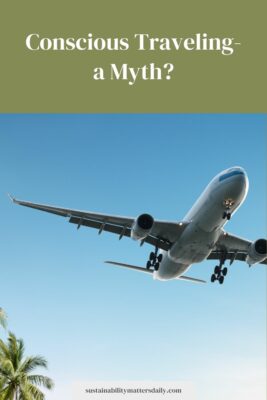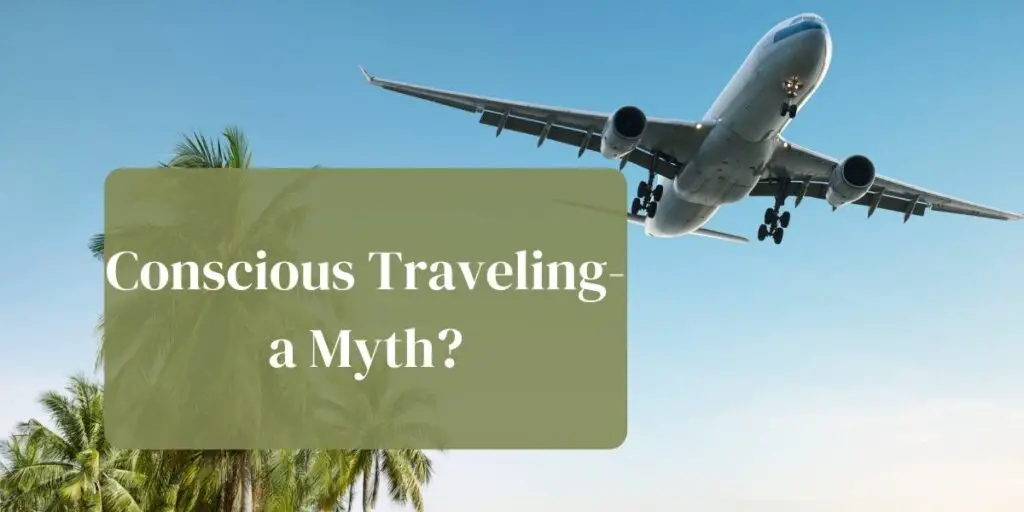Many websites and blogs try to glorify the development that happens in the travel industry. People tend to use buzzwords such as “eco-traveling” and “conscious traveling” to shed light on their low CO2 emissions while traveling. But the problem is that there are so many things that are going in the wrong direction.
This is an article where I go in-depth on some of the factors that might give you a more realistic picture of where the travel industry is heading.

Table of Contents
- 1. Chinas economic boom and their eager to grow
- 2. “How many airports were they going to build in China? Are you joking?”
- 3. People are traveling longer distances
- 4. Digital nomads
- “Do you want to live in paradise while working in an e-commerce related business?”
- 5. More and more people prefer to travel on a (big) boat
- 6. Do people care about nature when they travel? (Disclaimer: no, they don`t)
- #7: Greenwashing
- #8: Elephant rides and tiger “parks”
1. Chinas economic boom and their eager to grow
Did you know that the largest airport in the world is located in China? In October 2019, chairman Xi Jinping opened Daxing airport outside Beijing. The starfish-like airport is expected to handle about 75 million passengers every year.
Why is it a problem that China builds this airport?
Because it will have a significant effect on the travel habits of Chinese people. As I am writing this, less than 2 % of the total Chinese population has been abroad. This is drastically going to change. According to this article by The Telegraph, “only” 15.1 million Chinese people went abroad in 2000. Fast forward 19 years and the number is 149.7 million. In less than two decades, we have seen a 1300 % growth in the number of Chinese nationals that travel abroad.
That is a massive number which creates massive problems.
Overtourism in “neighboring” countries like Thailand and Vietnam is one problem. The total CO2 emission from the aviation industry is another one.
2. “How many airports were they going to build in China? Are you joking?“
This was the reaction I got when I told my friend about the latest “aviation news” from China. The Chinese government has decided to build no less than 200 airports in 2019. That is more than one new airport every second day!
Madness.
PS! I am not trying to criticize China for building airports or Chinese people for exploring the world. What I try to do is simply explain that these things will have a massive negative environmental impact. On the other side, it happens a lot of interesting things over there – like the high-speed trains and increased use of solar panels.
3. People are traveling longer distances
Ooookay, let`s stop talking about China. People are not only traveling more frequently. We are also traveling longer distances. In the 70`s and 80`s “no one” had been to Machu Pichu. These days it`s almost abnormal to not have been there just for the sake of taking a beautiful Instagram picture. Well, that might be a slight exaggeration, but you get the point.
Just for the sake of it, this is a beautiful Instagram picture from Machu Pichu:
What causes this trend is quite complex to describe. Increased globalization does have an impact. Flight tickets are also something that is less expensive today compared to 30 years ago. In addition to that, we have a constant reminder on social media that someone is simply living a better life than us…which “forces” people to visit all the cool places in the world. One publication called Skift published an article where they published a third explanation. They were stating that our new long-distance travel habits could be explained by the rise of Millenials, quote: “Millennials don’t always want to go on vacation to places their parents like to visit. Airlines are starting to take notice. “
4. Digital nomads
“Do you want to live in paradise while working in an e-commerce related business?”
This is a typical slogan that can be posted on websites trying to promote a lifestyle called digital nomad. The definition of a digital nomad is quite blurry depending on who you ask. But in general, it is someone that don’t have an office to go to – but are still working. All the income they generate will be done through their computers. They might own an Amazon store, be a copywriter for a newspaper, be a designer or own their own blog/website.
Why is this an environmental problem?
These people are not traveling to different places in their local city. Most of them are going to places like Vietnam, Thailand, China, and the Philippines. These are countries with a low cost of living combined with summer “all year round”. As we are now getting a quite large group (40 million digital nomads according to certain sources) of people traveling around without a fixed home base, traveling alone causes a huge carbon footprint.
5. More and more people prefer to travel on a (big) boat
I will never forget the footage of local people in Venice trying to stop cruise boats from entering their city. And by “stopping them“, I mean trying to throw rocks and fireworks at the boat – in addition to shouting profanity to the tourists.
This clip illustrates how tired they are of overtourism in Venice:
Venice is not alone. We have seen similar protests in countries like Iceland, Norway, Spain, and Portugal.
Why do we see these protests?
Cruise Lines International Association published a report in 2019 where they predict the future of cruise travel. From an environmental perspective, some of the pages in their .pdf document should worry you. Between 2009 and 2019, the global number of cruise passengers has almost doubled. This is illustrated in the document that I was just linking to, and can be seen in the screenshot below:

Just to be clear, there are two reasons why the arrivals of these cruise ships are “annoying”:
– Overpopulation. Too many people arriving in an already densely populated area.
– Air pollution directly from the boats.
6. Do people care about nature when they travel? (Disclaimer: no, they don`t)
Let me give you three quick examples of beautiful natural areas that have been negatively affected by tourism.
1) Santorini, Greece.
2) The Great Pyramids, Egypt.
3) Boracay Islands, Philippines.
These are just some places that have been destroyed by mass tourism. I have written a blog post about this problem in the past. If you click this link , you are presented with a lot of places around the world that are destroyed by humans.
Once something is destroyed, it is quite hard to imagine that nature will “take these places back”. You can limit the number of tourists that are going somewhere in the future, but you can`t always fix a natural place that is broken.
#7: Greenwashing
If you haven’t heard about the term greenwashing, it’s about time. The phrase is used to describe businesses that use words like “green” and “eco-friendly” in their marketing efforts despite not really being environmentally friendly at all. There are loads of examples of misleading customers to believe that they buy eco-friendly services in the travel industry.
One example was highlighted by South China Morning Post. In this article they are referring to a study done in Great Britain. Apparently, 50 % of the hotels in UK would, quote: “mislead guests with their planet-saving policies. “
How can you make sure to not support these companies?
By doing research. The information might be hidden from the public, which means that you need to go directly to step 2: contact the company and ask for documentation that their trip/hotel is aligned with a green profile.
How can you make golfing more eco-friendly? Learn 5 tips.
#8: Elephant rides and tiger “parks”
I think we already established the fact that the travel industry has a huge impact on the total CO2 emissions. But we also have to shed some light on the fact that a lot of animals are being used to make tourists happy. This topic might even deserve its own article, but I will give two examples of animals that suffer as a direct result of pleasing demanding/lazy tourists:
1. Elephant rides in Thailand.
Riding an elephant through the South-Asian jungle. It doesn’t get more exotic than that, does it?
Well, that might be true. But several newspapers and animal rights organizations have highlighted the fact that these animals are (literally) working under hard conditions. BBC reported in 2017 that more than 3000 elephants “were living in “severely cruel” conditions. Many were bound with chains less than 3m long and were forced to stand on concrete floors close to loud roads, crowds and music. “
2. Donkeys carrying overweight tourists.
CNN published an article in 2018 about how donkeys were used in Greece to carry overweight tourists up a cliff. People went mental after seeing the footage (and reading the article), which is totally understandable.
PETA uploaded a video on Youtube showing how the donkeys are working for 12 hours, carrying too much weight and not getting enough water:
In addition to this, many people have been angry over the fact that tigers are being kept in small cages to please tourists. Taking a picture with a small baby tiger to put on your Instagram account has almost become normal.



Hi Amund,
Although my actual travel has been minimal and mostly short distance (I typically drive to places in and around my own state), my dream since a child was to travel the world and live an adventurous life. However, as an adult, I’ve become more and more interested and then worried about climate change and living sustainably.
I’m familiar with many of the issues you’ve presented in this article. My question is, do you believe there is ANY way to travel extensively and/or internationally in a way that is more sustainable and less damaging to the environment? I’m still new to learning about this topic, so I was hoping you had some insight you could share. If the answer is no, then I’ll certainly have some soul-searching and lifestyle changes to make.
I’d really like to hear from someone with your expertise on the subject instead of the biased info I see from travel bloggers who are being paid to sell destinations. It’s hard to trust what they say when their livelihoods depend on interest in travel and tourism.
Thank you!
Hi Lisa, thanks for your comment. You’re bringing up something very relevant.
I do not believe that consumers will change the way they travel. For instance, people in developing countries have just “discovered” that you can travel the world. And with an increased number of people in the middle class in China and India, we’re just gonna see the industry boom when the pandemic is over.
From a solution point of view, I believe something must change on a political level. The airline companies have zero motivation to change their emission model. Unless the government(s) push for higher pricing on airline tickets, I’m not sure that we really can do anything.
I’m sorry for having such a pessimistic take on this. But as I learn more about it, I become more and more pessimistic. Which isn’t really great.
Best,
Superb article, thanks a lot for showing this side of the travel industry. While reading travel blogs and magazines, you can easily get the impression that the industry has gone from being “eco-harmful” to “environmentally friendly”.
Sad thing is…..that is simply not true. So when you post things like this, you actually force airline companies, hotels and AirBNB hosts to actuallly DO SOMETHING ABOUT THEIR CARBON FOOTPRINT!
Hi Sarah,
indeed. This is a part of the travel industry that isn’t exactly talked about too much.